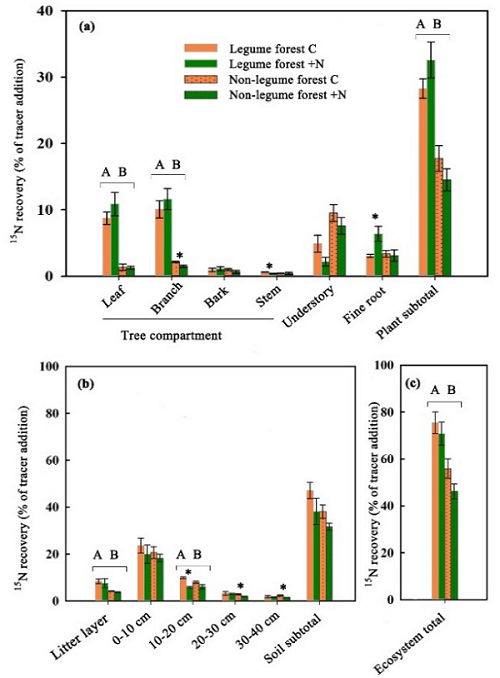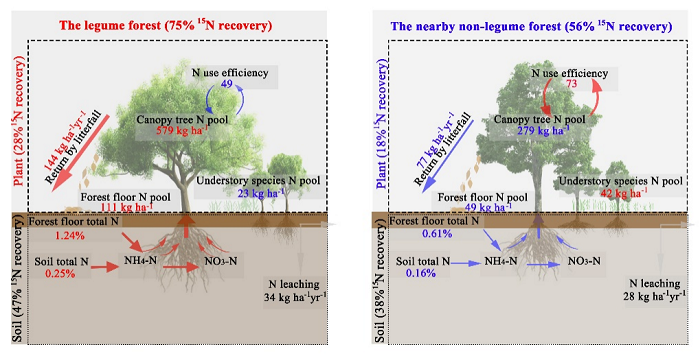High retention of 15N-labeled nitrogen in a N-rich legume forest
Human activities have increased atmospheric nitrogen (N) deposition and affected the structure and function of forest ecosystems. The effects of increased N deposition on forests greatly depend on the fates of the deposited N. Legume trees are widely distributed across terrestrial forests, especially in the tropics. They play a key role in driving N and carbon (C) cycling of the forest ecosystems because of symbiotic biological N-fixation. However, until now, considerable progress on the role of legumes in the N cycle has mainly focused on their N-fixing efficiency and N-fixing strategies. Our knowledge of the dependency and retention of external N inputs such as atmospheric deposition in legume forests remains poor, which limits the global assessment of the impact of N deposition and reduces the accuracy of terrestrial ecosystem N budget estimates. The abundant N-fixing plant species in N-rich tropical forests leads to controversies on the N retention capacities of legume forests.
In order to address the fates of external N inputs (deposited N and/or N fertilizer) in the legume forest and compare differences between legume and non-legume forests, Dr. Jinhua Mao and others from the research group of Ecosystem Management (Principal Investigator: Dr. Jiangming Mo) of South China Botanical Garden, Chinese Academy of Sciences, carried out the first ecosystem-scale 15N labeling experiment in a legume plantation forest (Acacia auriculiformis) and a nearby non-legume forest (Eucalyptus urophylla), which has been experienced long-term N addition since 2010. The results showed that 1) the legume forest had a high N retention capacity for deposited N regardless of its high soil N status. The legume forest showed significantly higher ecosystem 15N recovery than that in the non-legume forest; 2) Mineral soil was the major sink for deposited N, but no significant difference in soil 15N recovery observed between the two forest types. The higher 15N recovery in the legume forest than the non-legume forest was mainly driven by the legume trees; 3) Long-term (ten-year) N addition did not significantly change the 15N recovery patterns of both forests, which may be related to the higher soil N status of the studied forests. Our findings indicate that N-rich legume-dominated forest is a strong short-term sink for deposited N even under high N inputs, and legume trees play a key role in the strong capacity of the legume forest to retain N. This result emphasizes the necessity to incorporate the influence of legume forests in the Earth system nitrogen cycle model to accurately assess the ecological effects of global nitrogen deposition on terrestrial ecosystems. High N retention capacity of the legume forest in the current study may help explain an apparent paradox in the biogeochemical literature - the high N-fixer abundance and richness in the relatively N-rich tropics.
This study, entitled “Unexpected high retention of 15N-labeled nitrogen in a tropical legume forest under long-term nitrogen enrichment”, was published online in Global Change Biology. (https://doi.org/10.1111/gcb.16005)


File Download: